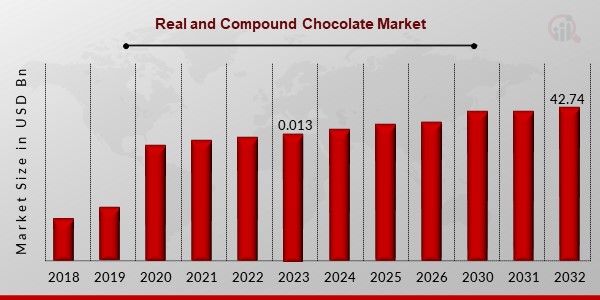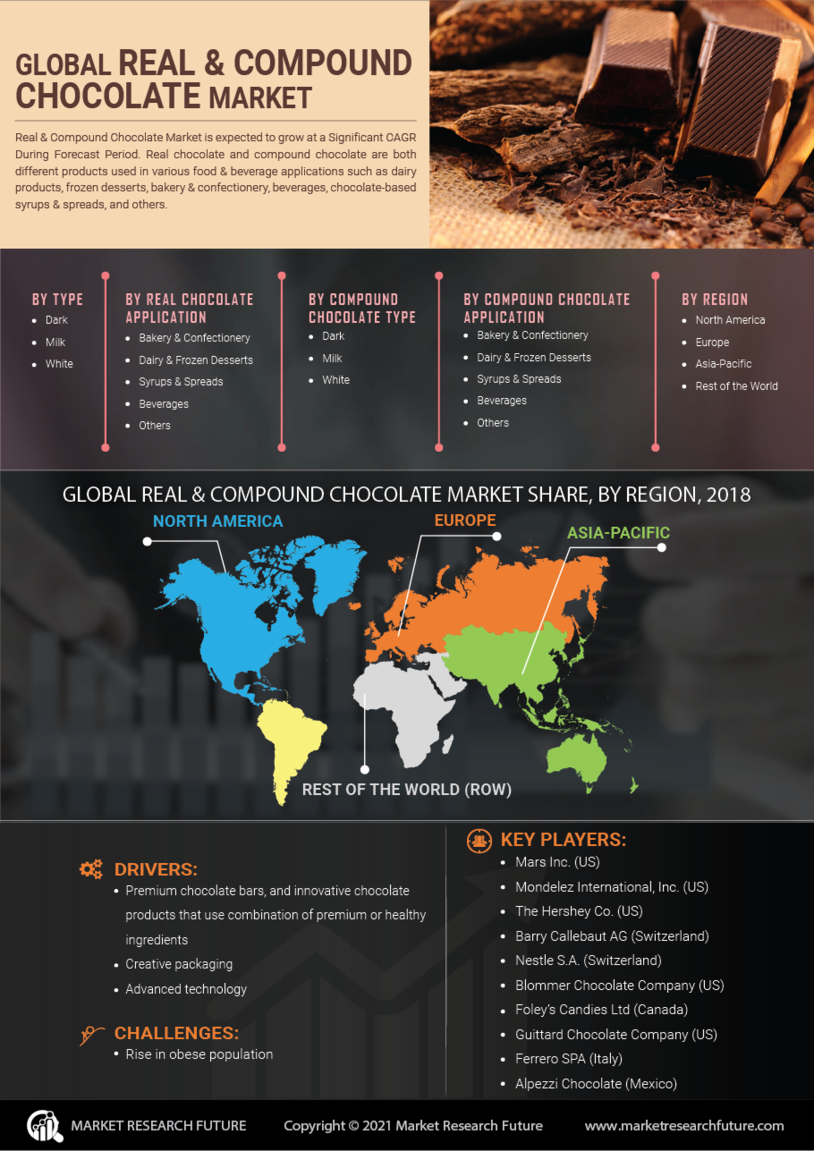Real Compound Chocolate Market Summary
As per MRFR Analysis, the global Real and Compound Chocolate Market is projected to reach USD 42.74 billion by 2032, with a CAGR of 5.69% from 2024 to 2032. The real chocolate segment generated USD 0.013078 billion in 2023, expected to grow at a CAGR of 3.1% during the same period. Real chocolate is made from milk powder, sugar, cocoa butter, and cocoa mass, while compound chocolate substitutes these with vegetable oils and cocoa powder, making it more cost-effective. The compound chocolate market is anticipated to grow faster due to its affordability and versatility in various applications, including ice creams and baked goods. Key players are focusing on geographic expansion, product innovation, and R&D to enhance their market presence.
Key Market Trends & Highlights
The market is witnessing significant trends driven by consumer preferences and cost factors.
- The global real chocolate market is expected to grow at a CAGR of 3.1% from 2024 to 2032.
- Compound chocolate is projected to register a higher CAGR due to its lower cost and functional versatility.
- Europe accounted for nearly 42% of the global market share in 2021, driven by high demand for dark chocolate.
- Asia-Pacific is anticipated to have the highest CAGR during 2022-2030, fueled by market expansion and application growth.
Market Size & Forecast
2023 Market Size: USD 0.013078 Billion
2032 Market Size: USD 42.74 Billion
CAGR (2024-2032): 5.69%
CAGR (Real Chocolate 2024-2032): 3.1%
Major Players
Mars Inc. (US), Mondelez International, Inc. (US), The Hershey Co. (US), Barry Callebaut AG (Switzerland), Nestle S.A. (Switzerland), Blommer Chocolate Company (US), Foley’s Candies Ltd (Canada), Guittard Chocolate Company (US), Ferrero SPA (Italy), Alpezzi Chocolate (Mexico)

Real chocolate and compound chocolate are both different products used in various food & beverage applications such as dairy products, frozen desserts, bakery & confectionery, beverages, chocolate-based syrups & spreads, and others. The difference between the products is purely based on the ingredients used. Real chocolate consists of milk powder, sugar, and cocoa butter and cocoa mass, whereas, in compound chocolate, the cocoa bean derived cocoa butter and cocoa mass are replaced by vegetable oils and cocoa powder respectively.
The market for compound chocolate is expected to register a higher CAGR during the forecast period due to the low cost of compound chocolate and its increasing application in less expensive chocolate-based products. Additionally, the ability of compound chocolate to harden without tempering is promoting its use in ice creams, confectionery products, bakery products, and few other frozen desserts. Compound chocolate efficiently replicates the functional attributes of real chocolate at a lower price, which, in turn, is boosting the growth of compound chocolate market as compared to the real chocolate market. The key industry players in the real & compound chocolate market have adopted strategies such as geographic expansion, new product launch, acquisitions, agreement, and R&D to strengthen their business portfolio & presence. Most of the companies operating in this market are focusing on expanding their operations across new geographies, augmenting their capabilities and investing in research and development to offer products with better functionality.
Market Segmentation
The global real & compound chocolate market has been segmented based on type, application, and region.
By type, the global real & compound chocolate market has been classified as dark, white, and milk.
Based on application, real & compound chocolate market is segregated into, bakery & confectionery, dairy & frozen desserts, syrups & spreads, beverages, and others.
The global real & compound chocolate market has been studied with regard to four key regions—North America, Europe, Asia-Pacific, and the rest of the world.
The North American real & compound chocolate market has further been segmented into the US, Canada, and Mexico. The European real chocolate market has been classified as the UK, Germany, France, Italy, and the rest of Europe. The real chocolate market in Asia-Pacific has been divided into China, India, Japan, Australia and New Zealand, and the rest of Asia-Pacific. The real chocolate market in the rest of the world has been segmented into Latin America, the Middle East, and Africa.
The global compound chocolate market has been segmented based on type, application, and region.
By type, the global compound chocolate market has been classified as dark, white, and milk.
Based on application, the market is segregated into, bakery & confectionery, dairy & frozen desserts, syrups & spreads, beverages, and others.
The global compound chocolate market has been studied with regard to four key regions—North America, Europe, Asia-Pacific, and the rest of the world.
The North American compound chocolate market has further been segmented into the US, Canada, and Mexico. The European compound chocolate market has been classified as the UK, Germany, France, Italy, and the rest of Europe. The compound chocolate market in Asia-Pacific has been divided into China, India, Japan, Australia and New Zealand, and the rest of Asia-Pacific. The compound chocolate market in the rest of the world has been segmented into Latin America, the Middle East, and Africa.
Key Players
- Mondelez International, Inc. (US)
- Nestle S.A. (Switzerland)
- Blommer Chocolate Company (US)
- Foley’s Candies Ltd (Canada)
- Guittard Chocolate Company (US)
- Alpezzi Chocolate (Mexico)
Regional Market Summary
In both, global real compound chocolate market and global compound chocolate market, in 2021, Europe garnered the largest revenue share of nearly 42%. High demand for dark chocolate in Europe due to its health benefits is amongst the major determinant driving the growth of the regional market. Belgium, Germany, the UK, Italy, and Switzerland are the major country-level markets contributing to the growth of Europe real & compound chocolate market. However, Asia-Pacific is expected to register the highest CAGR during the forecast period 2022–2030 due to the increasing expansion of market players in the region and growth of application industries in Asia-Pacific.
Real Chocolate Market, by Type
Real Chocolate Market, by Application
Real Chocolate Market, by Region
-
Asia-Pacific
- Australia and New Zealand
Intended Audience
- Real & compound chocolate manufacturers
- Food and beverage manufacturers
- Traders, importers and exporters
- Retailers and wholesalers
|
Attribute/Metric
|
Details
|
|
Market Size
|
USD 42.74 Billion
|
|
Compound Annual Growth Rate (CAGR)
|
5.69% (2024-2032)
|
|
Base Year
|
2023
|
|
Market Forecast Period
|
2024-2032
|
|
Historical Data
|
2020- 2022
|
|
Market Forecast Units
|
Value (USD Billion)
|
|
Report Coverage
|
Revenue Forecast, Market Competitive Landscape, Growth Factors, and Trends
|
|
Segments Covered
|
By Real Chocolate Type, Real Chocolate Application, Compound Chocolate Type, Compound Chocolate Application, and Region
|
|
Geographies Covered
|
North America, Europe, Asia Pacific, and the Rest of the World
|
|
Countries Covered
|
The US, Canada, Germany, France, UK, Italy, Spain, China, Japan, India, Australia, South Korea
|
|
Key Companies Profiled
|
Mars Inc. (US), Mondelez International, Inc. (US), The Hershey Co. (US), Barry Callebaut AG (Switzerland), Nestle S.A. (Switzerland), Blommer Chocolate Company (US), Foley’s Candies Ltd (Canada), Guittard Chocolate Company (US), Ferrero SPA (Italy), and Alpezzi Chocolate (Mexico)
|
|
Key Market Opportunities
|
Compound chocolate efficiently replicates the functional attributes of real chocolate at a lower price
|
|
Key Market Dynamics
|
Low cost of compound chocolate, Ability of compound chocolate to harden without tempering
|
Real Compound Chocolate Market Highlights:
Frequently Asked Questions (FAQ) :
Real & compound chocolate market projected to grow at a 5.69% CAGR between 2024-2032.
Europe is expected to dominate the real & compound chocolate market.
The companies such as Mars Inc. (US), Mondelez International, Inc. (US), The Hershey Co. (US), Barry Callebaut AG (Switzerland), Nestle S.A. (Switzerland), Blommer Chocolate Company (US), Foley’s Candies Ltd (Canada), Guittard Chocolate Company (US), Ferrero SPA (Italy), and Alpezzi Chocolate (Mexico) are dictating the growth trends in the global market.
Some major applications real & compound chocolate include beverages, syrups and spreads, dairy and frozen desserts, and others.
Different strategies adopted key players to strengthen their presence in the real & compound chocolate market include R&D, agreement, expansion, and new product launch.
White, milk, and dark are the different types of real & compound chocolate.















